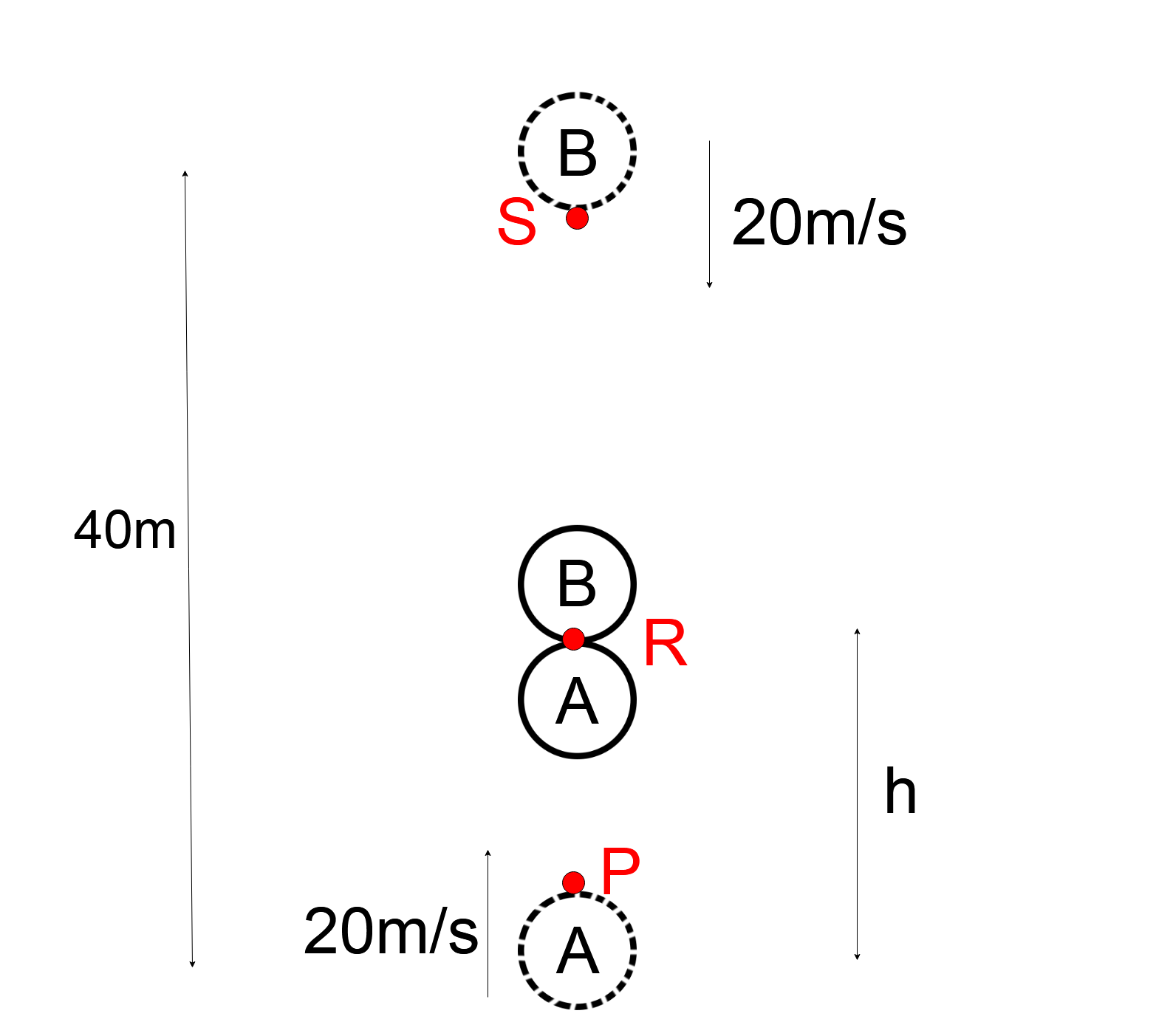
Two balls $A$ and $B$ are simultaneously thrown. $A$ is thrown from the ground level with a velocity of $20m{s^{ - 1}}$ in the upward direction $B$ is thrown from a height of $40m$ in the downward direction with the same velocity. Where will the two balls meet?
A. $15m$
B. $25m$
C. $35m$
D. $45m$
Answer
576.6k+ views
Hint: you can start by writing the second equation of motion, i.e. $S = ut + \dfrac{1}{2}a{t^2}$. Then use this equation for both balls $A$ and $B$, and add the equations you get to obtain the value of $t$. Then use the value of $t$ to find the height where the balls meet.
Complete answer:
Let’s assume that the balls meet at a Point R and are at a height $h$ from the ground and will meet in time $t$ .

Given, the initial velocity of the ball that is thrown upwards is $20m/s$ from point P. The acceleration due to gravity acts in the downward direction ( $ - g$ ).
The ball $B$ is initially at a point S. The initial height of the ball that is thrown in the downward direction is $40m$ and the velocity of the ball is $20m{s^{ - 1}}$ .
The diagram of the following situation is as follows
We know that the second equation of motion is
$S = ut + \dfrac{1}{2}a{t^2}$
Here, $s = $ Height
$u = $ The initial velocity of the body
$v = $ The final velocity of the body
$a = $ Acceleration of the body
$t = $ Time
So, using the second equation of motion, for the motion of the ball $A$ from point P to point R, we get
$h = 20 \times t + \dfrac{1}{2} \times \left( { - g} \right) \times {t^2}$
$h = 20t - \dfrac{1}{2}g{t^2}$ (Equation 1)
And, using the second equation of motion, for the motion of ball $B$ from point S to point R, we get
$40 - h = 20 \times t + \dfrac{1}{2} \times g \times {t^2}$
$40 - h = 20t + \dfrac{1}{2}g{t^2}$ (Equation 2)
Adding equation 1 and equation 2, we get
$h + 40 - h = 20t - \dfrac{1}{2}g{t^2} + 20t + \dfrac{1}{2}g{t^2}$
$40 = 40t$
$t = 1\sec $
Substituting the value of $t$ in equation 2, we get
$40 - h = 20 \times 1 + \dfrac{1}{2} \times 10 \times {\left( 1 \right)^2}$ (Assuming $g = 10m/{s^2}$ )
$h = 40 - 25$
$h = 15m$
So, the correct answer is “Option A”.
Note:
In this type of problems, we usually ignore possible interfering factors such as air resistance, and the gravitational pull of other celestial objects, unless stated otherwise. In practice, the balls would face these ignored factors and this will if not greatly, to some extent cause variability in the results obtained.
Complete answer:
Let’s assume that the balls meet at a Point R and are at a height $h$ from the ground and will meet in time $t$ .

Given, the initial velocity of the ball that is thrown upwards is $20m/s$ from point P. The acceleration due to gravity acts in the downward direction ( $ - g$ ).
The ball $B$ is initially at a point S. The initial height of the ball that is thrown in the downward direction is $40m$ and the velocity of the ball is $20m{s^{ - 1}}$ .
The diagram of the following situation is as follows
We know that the second equation of motion is
$S = ut + \dfrac{1}{2}a{t^2}$
Here, $s = $ Height
$u = $ The initial velocity of the body
$v = $ The final velocity of the body
$a = $ Acceleration of the body
$t = $ Time
So, using the second equation of motion, for the motion of the ball $A$ from point P to point R, we get
$h = 20 \times t + \dfrac{1}{2} \times \left( { - g} \right) \times {t^2}$
$h = 20t - \dfrac{1}{2}g{t^2}$ (Equation 1)
And, using the second equation of motion, for the motion of ball $B$ from point S to point R, we get
$40 - h = 20 \times t + \dfrac{1}{2} \times g \times {t^2}$
$40 - h = 20t + \dfrac{1}{2}g{t^2}$ (Equation 2)
Adding equation 1 and equation 2, we get
$h + 40 - h = 20t - \dfrac{1}{2}g{t^2} + 20t + \dfrac{1}{2}g{t^2}$
$40 = 40t$
$t = 1\sec $
Substituting the value of $t$ in equation 2, we get
$40 - h = 20 \times 1 + \dfrac{1}{2} \times 10 \times {\left( 1 \right)^2}$ (Assuming $g = 10m/{s^2}$ )
$h = 40 - 25$
$h = 15m$
So, the correct answer is “Option A”.
Note:
In this type of problems, we usually ignore possible interfering factors such as air resistance, and the gravitational pull of other celestial objects, unless stated otherwise. In practice, the balls would face these ignored factors and this will if not greatly, to some extent cause variability in the results obtained.
Recently Updated Pages
Why are manures considered better than fertilizers class 11 biology CBSE

Find the coordinates of the midpoint of the line segment class 11 maths CBSE

Distinguish between static friction limiting friction class 11 physics CBSE

The Chairman of the constituent Assembly was A Jawaharlal class 11 social science CBSE

The first National Commission on Labour NCL submitted class 11 social science CBSE

Number of all subshell of n + l 7 is A 4 B 5 C 6 D class 11 chemistry CBSE

Trending doubts
What is meant by exothermic and endothermic reactions class 11 chemistry CBSE

1 Quintal is equal to a 110 kg b 10 kg c 100kg d 1000 class 11 physics CBSE

What are Quantum numbers Explain the quantum number class 11 chemistry CBSE

What is periodicity class 11 chemistry CBSE

What is a periderm How does periderm formation take class 11 biology CBSE

Mention the basic forces in nature class 11 physics CBSE




